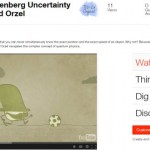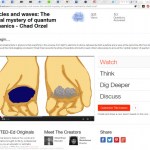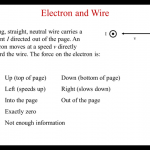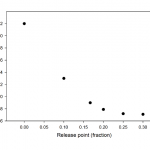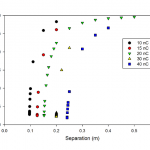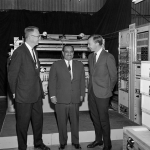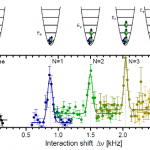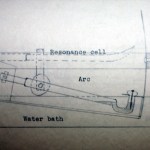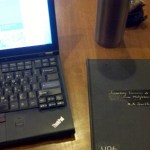Theory
As mentioned last week, I was the on-hand expert for the Secret Science Club's foray into Massachusetts, a screening of the movie Particle Fever held at MASS MoCA. This worked out nicely in a lot of respects-- it gave me an excuse to visit the newly renovated Clark Art Institute in Williamstown and check out the spiffy new library at Williams (where they have my second book on the shelves, but not my first; I may need to send them an author copy in lieu of a check this year...). I also did some random nostalgia things like grabbing dinner at Colonial Pizza (now in a strip mall halfway to…
The third of the videos I wrote for TED-Ed is now live: Schrödinger's Cat: A Thought Experiment in Quantum Mechanics.This is using basically the same argument I outlined in this post, but with awesome animation courtesy of Agota Vegso. I'm impressed by how close the images that ended up in the video are to the pictures I had in my mind while I was writing it.
As I said in that old post, I dithered for a bit about whether to run with this argument, but decided I liked it enough to go ahead. You can legitimately quibble about some of the phrasing being a little too definite (or that Schrödinger…
The second one of the TED-Ed lessons I wrote about quantum physics has now been published: What Is the Heisenberg Uncertainty Principle. This is, again, very similar to stuff I've written before, specifically this old blog post and the relevant chapter of How to Teach [Quantum] Physics to Your Dog.
As usual, I tried but probably failed to do justice to other interpretations in the "Dig Deeper" references I sent; outraged Bohmians should feel free to comment either here or there with better explanations.
Again, it's really fun to see the images the animators found to put to my words. I love…
My TED@NYC adventure last fall didn't turn into an invite to the big TED meeting, but it did lead to a cool opportunity that is another of the very cool developments I've been teasing for a while now: I've written some scripts for lessons to be posted with TED-Ed. The first of these, on particle-wave duality just went live today.
The content here is very similar to my talk last fall, which is, in turn, very similar to Chapter 8 of Eureka: a historical survey of the development of quantum physics. I did the script for this, which was then turned over to professional animators, who did a great…
I didn't write a summary of the third day of "Quantum Boot Camp" to go with my Day One and Day Two summaries for a simple reason: I would've needed to do that on Saturday, and I spent Saturday in transit back to the US. More than that, though, it was harder to summarize than the other two days, because my talk was the middle of three, and thus I spent most of the first talk fiddling with my slides and fretting, and most of the third fighting off the post-talk adrenaline crash.
Happily, Sedeer at Inspiring Science offers a summary of the first two talks, namely Larus Thorlacius from Nordita…
The second day of the "Quantum Boot Camp" was much lighter on talks. The only speaker was Ray Laflamme from the Institute for Quantum Computing in Waterloo, who gave a nice introduction to quantum technologies. While he did spend a bit of time at the start going through Shor's algorithm for factoring numbers (following up a discussion from Wednesday), he mostly focused on ways to use quantum physics to improve sensors of technological interest.
So, for example, he talked about how efforts to develop techniques for error-correcting codes in liquid state NMR quantum computing led to the…
Since this part of the trip is actually work-like, I might as well dust off the blog and post some actual physics content. Not coincidentally, this also provides a way to put off fretting about my talk tomorrow...
I'm at the Nordita Workshop for Science Writers on quantum theory, which a couple of the attending writers have referred to online as boot camp, though in an affectionate way. The idea is to provide a short crash course on cool quantum physics, so as to give writers a bit more background in subjects they might need to cover.
The first talk was from Rainer Kaltenbaek (whose name I…
Every now and then, I run across a question in class that I genuinely don't know how to answer. If I'm lucky, this happens when I'm prepping a class, rather than when a student asks it live. Like today, when I noticed the above discussion question in my slides (reproduced at the bottom as well for those reading via RSS).
The discussion question itself is perfectly straightforward-- the current in the wire creates a magnetic field, the moving electron interacts with that, and getting the direction of the force is a straightforward right-hand-rule problem. I'll pose this to the class and ask…
So, there was this big story in cosmology the other day-- Tom Levenson's write-up is very nice-- which has been hailed as one of the greatest discoveries since the last greatest discovery, blah, blah, blah. And now that a few days have passed, we're starting to see the inevitable backlash, ranging from detailed technical analyses of possible other explanations to more general musings about the nature of peer review. I'm not qualified to evaluate the former, so I'm going to talk a bit about the latter.
The title of that Atlantic post is "'One of the Greatest Discoveries in the History of…
I realize people are getting sick of reading me talk about this charged-tape business, which has run to one, two, three, four posts at this point. Truth be told, I'm losing enthusiasm for it myself. So this will be the final post, at least for now...
As I mentioned on Twitter, as I type this stuff up for the blog, I've toyed with the idea of hanging onto it instead, and writing it up for The American Journal of Physics or The Physics Teacher, so I could get a little professional credit for it. There are two problems with that (other than that some stick-in-the-mud editor or reviewer might…
Ashutosh Jogalekar has a response to my post from yesterday complaining about his earlier post on whether multiverses represent a philosophical crisis for physics. I suspect we actually disagree less than that back-and-forth makes it seem-- he acknowledges my main point, which was that fundamental theoretical physics is a small subset of physics as a whole, and I don't disagree with his point that physics as a discipline has long been characterized by a reductionist sort of approach-- always trying to get to smaller numbers of fundamental principles.
Our real point of disagreement, I think,…
The very last section of the book-in-progress (at least the draft that's with my editor right now...) is titled "Science Is Never Over," and talks about how there are a nearly infinite number of phenomena that you can investigate scientifically. The universe is a never-ending source of amazement and wonder, with surprisingly rich dynamics in the simplest of things. I mean, look at the thousands of words I've gotten out of talking about sticky tape...
This is why I sigh heavily whenever I see a title like Ashutosh Jogalekar's "Should Physicists Stop Looking for Fundamental Laws. This is, at…
In the previous post about simulating the attraction between sticky tapes using VPython, I ended with a teaser mentioning that there was a discrepancy between the simulation and the theoretical solution from directly solving the equations. The problem is kind of subtle, but clearly visible in this graph from that post:
Data for the toy model version of the system, showing the equilibrium position as a function of initial separation.
In this, we see the equilibrium position that the mass-on-a-spring settles into as a function of the initial separation between the charges in the toy model.…
Having spent a lot of time solving equations related to sticky tape models, including trying to work solutions in my head while driving to Grandma and Grandpa's with the kids, and making some measurements of real tapes, there was only one thing left to do: try simulating this problem in VPython. Because I'm a physics nerd who knows just enough about programming to be dangerous...
Finding the full solution to the real sticky tape scenario is kind of a miserable process, because it involves a long continuous tape with charge all down its length, which is kind of complicated, and then there's a…
I know I said there weren't going to be physics posts for a while, but yesterday our Communications office passed along a media request about this paper on feedback cooling of BEC, from some sort of communications-person mailing list. I'd seen it talked up elsewhere-- here, for example, so I banged out an email to the reporter in question. Who didn't use any of my stuff in the story that ran late last night.
Having put in the work, though, I may as well get something out of it, so here's the email I sent. Questions in bold are from the original request. The paper is in the New Journal of…
In 1967, a team of scientists hauled a big pile of gear-- electronics, particle detectors, a giant slab of iron-- into the burial chamber at the base of one of the pyramids at Giza. This sounds like a scene from a science fiction or fantasy novel-- throw in the fact that their first attempt was interrupted by the Six Day War and you've got an element of a Tim Powers secret history story-- but the goal wasn't the opening of an interdimensional portal or the raising of the dead. Instead, they were using astrophysics to do archaeology: their detectors measured the number of cosmic ray particles…
Two papers with a similar theme crossed my social media feeds in the last couple of days. You might think this is just a weird coincidence, but I'm choosing to take it as a sign to write about them for the blog.
So, what are these papers, and what's the theme? One is the final publication of some results I saw at DAMOP and alluded to back in June, and the other is from this post by Doug Natelson. Both look at the transition from few-body to many-body physics.
And this is interesting, why? I mean, isn't it obvious that you just add some more bodies? OK, I guess that does need a little more…
Via social media, John Novak cashes in a Nobel Betting Pool win from a while back, asking:
Please explain to me the relationship between energy, entropy, and free energy. Like you would explain it to a two year old child.
Why? There is a statistical algorithm called Expectation Maximization which is often explained in terms of those three quantities. But apparently entropy is hard to understand because all the detail in the analogy is heaped on entropy part (with some side tracks in Kullback-Leibler divergences.) Since I have a background in communication theory, entropy is a perfectly…
Having spent a bunch of time talking about heavy stuff in the science blogging community, let's unwind a bit and kick the week off with a look back at an old Master's thesis. This one is from 1932, and is almost certainly a draft copy, because it's extremely cheaply bound in cardboard with the title hand-lettered on the front. There are a few corrections in the text as well, which is very short-- just 11 pages, not counting the figures at the end.
Again, this is interesting as much for what it doesn't contain as what it does. The subject matter is pretty mundane by modern standards-- just…
As noted in a previous post on Monte Carlo simulation in 1960, we recently came into possession of a large box of old Master's theses. The bulk of these are from the 50's and 60's, but there are some going back much farther. As I pass these every day I'm in the office, I thought it might be amusing to take a look at these for the blog, now and again. I don't plan to do a detailed examination of the quality of the science (at least, not necessarily), but to use this to look at how things have changed over the decades.
The first of these, pictured above, is one of the oldest: Secondary Emission…

